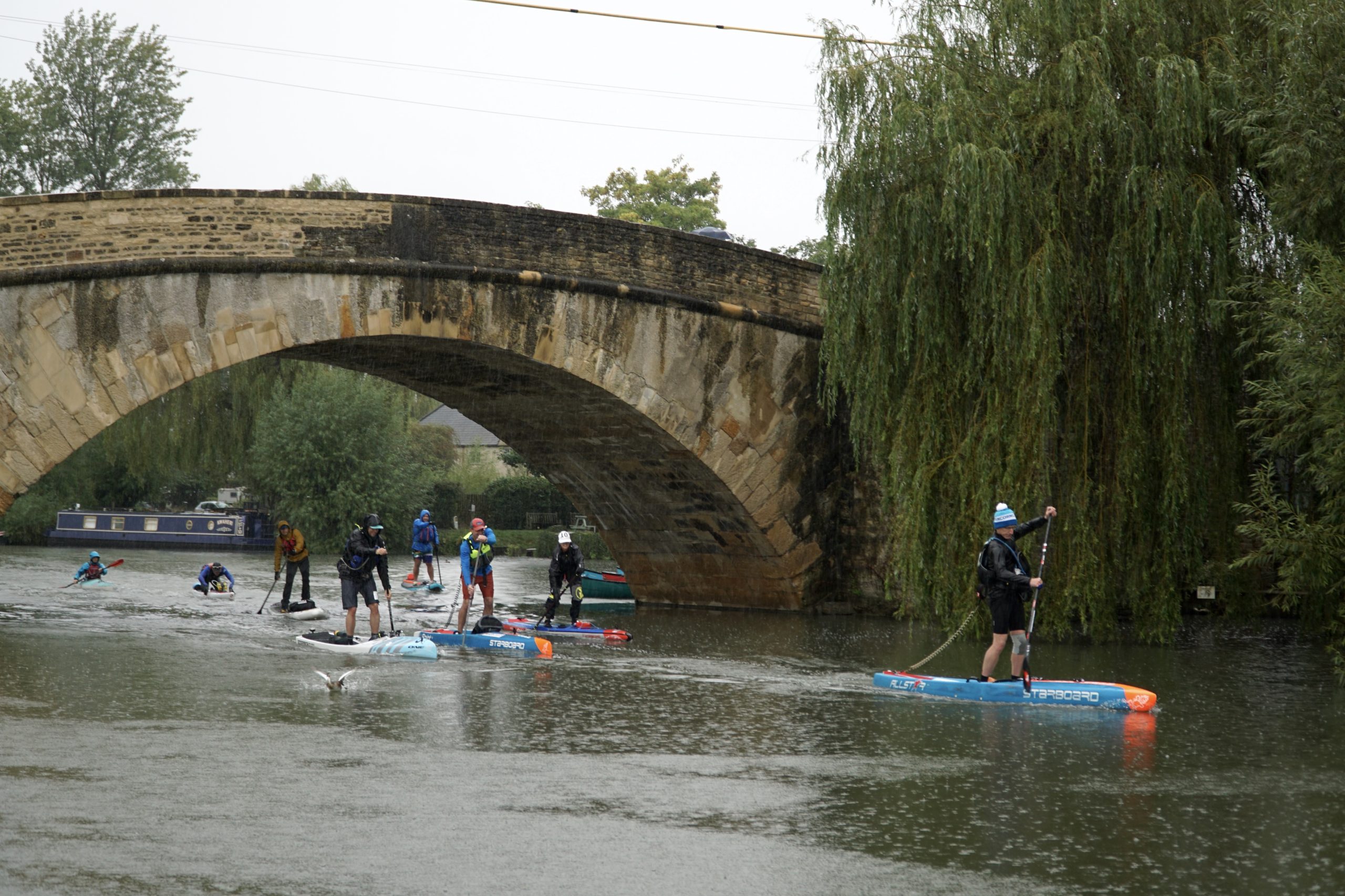
A play-by-play recap of the Thames 200 Ultra. Is this new race the UK’s SUP 11 Cities?
The inaugural Thames 200 Ultra was an ambitious undertaking: it was only announced three months ago (not very long to train for an ultra, let alone plan and run one), open to all sorts of crafts and experience levels (SUP, kayak, canoe, prone; amateur, elite), run by a first-time race director (who happens to hold the Devizes to Westminster race record in a double kayak), promoted by BBC nature presenter Steve Backshall, designed to help racers set new Guinness World Records… Could they really pull it off?
This weekend, nearly 100 competitors and hundreds more fans online and in-person found the answer. Not only did the Thames 200 Ultra achieve its aspirational aims, but the race attracted top paddlers from SUP, kayak, and canoe disciplines. As they reached the giant pink “RACE FINISH” banners 200 km from the start, almost every single paddler said the same thing: they’ll be back again next year.
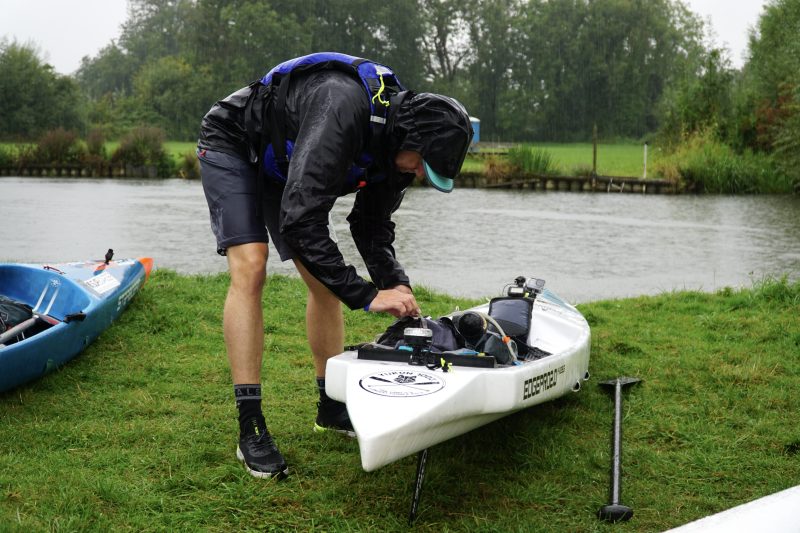

9:15 am: Spectators (human and bovine) braved the rain to watch the start of a record-setting race
The SUPs arrived first. Racers rushed with umbrellas between the registration and kit check areas before donning drysuits that looked out of place for August, but perfect for the pouring rain. James Fletcher stuck cameras to the front of his prone board before sliding into the water on his knees, paddling forward with his hands, ready to record the robust body of evidence he’d need to submit for the Fastest Prone Paddle of the River Thames. Michael Frost stood next to his inflatable SUP chatting jovially on the Paddle Daily x SUP Racer live stream: he confessed that he’d just started racing SUP in April, but after finishing some seriously impressive endurance races earlier in the year, he was ready to give the Thames 200 Ultra his best shot.
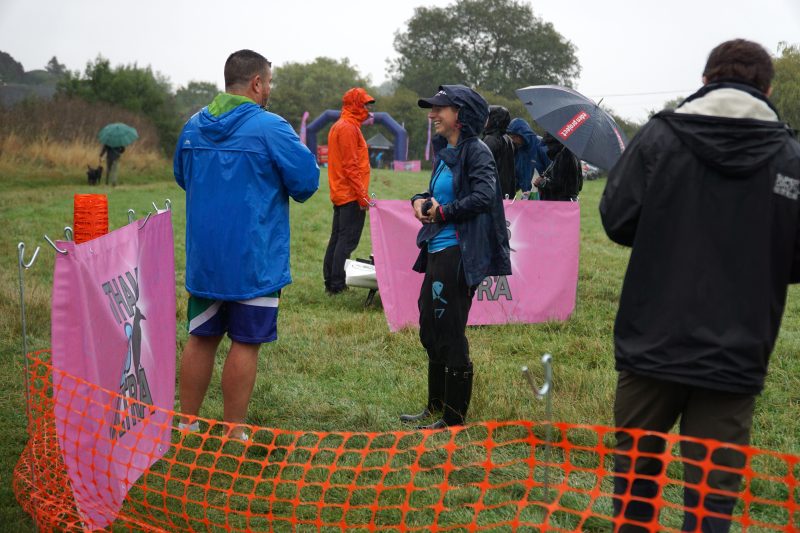
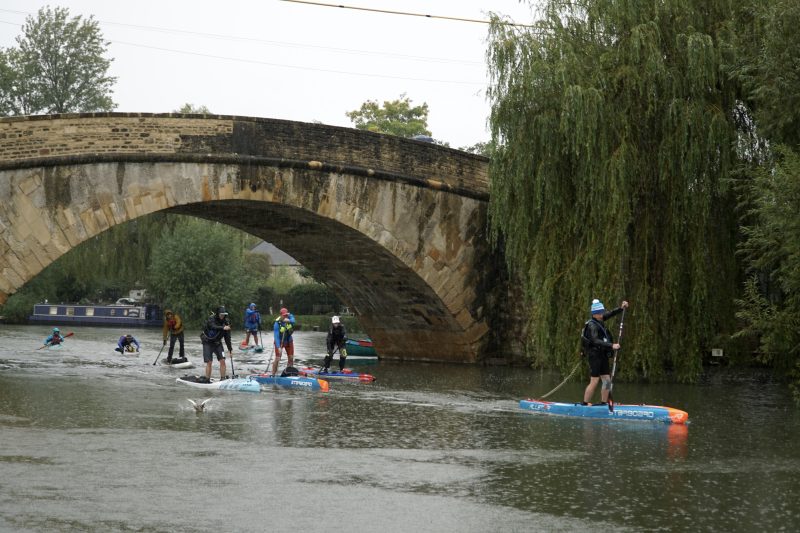
9:55 am. As more of the racers paddled toward the start line, the clock struck 9:55 and Alexandra Tyrer-Lomas was still taping on gels. Alex is a top SUP racer who represented England at European Championships in 2022 and won the Paddle Skedaddle this year, but her main goal for the Thames 200 Ultra was to use it as a test run for the record she’s targeting next year: Fastest Woman to Paddle the Length of the Thames. 9:56 am. Alex ducked her head for her support crew to slip her GPS tracker on. The rest of the group for the first start paddled toward the start line.
10 am. Nine racers on SUPs, kayaks, and a prone board paddled under Ha’penny Bridge, the official start of the race and the navigable Thames. The early start meant that competitors who would need 28-34 hours to finish would have plenty of time to hit the checkpoint cutoffs. The first wave of competitors paddled out of sight at “I still have 200 km left” pace, and rounded the first river bend.
10:06am. Alexandra raced under the bridge at “crap I just missed the start” pace – she caught up quickly and took fourth position amongst the SUPs. Hours later, Fletcher, Frost, and Tyrer-Lomas would each go on to withdraw from the race.

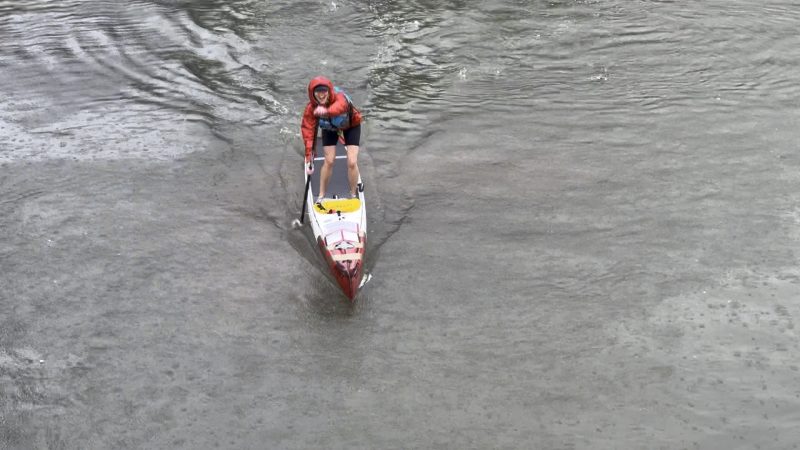
10:30 am. Leaders from the start.
In SUP, Gavin Symonds and Chris Davison took an early lead together. Both are veterans of the SUP 11 Cities, where paddlers race along the hundred year old route of the “Elfstedentocht” Dutch ice skating race. Chris also became the first SUP to paddle the Cheshire Ring in less than 30 hours last year: perfect portage practice for the Thames 200 Ultra.
Some vocal doubters on Facebook were sceptical that SUPs could complete the length of the Thames in under 30 hours: one called it “nigh on impossible”. For Gavin and Chris, this was just fuel for the fire. Right from the start, they knew they wanted to disprove the sceptics. Immediately, they started pushing each other. Tenured endurance racer Craig Sawyer dropped behind when he realised trying to keep up would lead to an early blow-up: “It was quite apparent early on that they were both going to be very competitive with each other. Chris stopped paddling to grab an energy gel, and all of a sudden, Gavin was catching him up. And that was in the first hour.”
It was around that point that Gavin and Chris had to call a truce – realising they were about the same speed and might regret pushing too hard off the start, they agreed to stick together. Aside from avoiding an early blow-out, it was also a logical choice for safety; and in Gavin’s words, “to not go mad staring at the trees.” The Thames 200 Ultra is one of the longest straight-through races that’s open to solo craft. For safety reasons, races like the straight-through Devizes to Westminster and Yukon 1000 limit entrants to doubles, or in the case of the Yukon 1000, two individual SUP paddlers paired as a team. Informally teaming up seemed to be an effective strategy, particularly on high portages in the hours of darkness.
4:30 pm. Too much heart.
James Fletcher had been training for this for months. Even before the Thames 200 Ultra race was announced, he knew he wanted to get the prone paddling record for the length of the Thames. His wife Kate paddled next to him in her kayak, their idea of a romantic adventure together. Paddling up and down the Scottish lochs, practising portages alone and together, managing a strict training schedule around their two-year-old’s schedule… Before the race, Kate admitted that one of the biggest things she was looking forward to was just being done with all the training. Although James has suffered from a heart condition for four years, he’s still been setting records and even prone paddled for twelve hours non-stop at the SUP Twelve earlier this year. So going into the Thames 200 Ultra, he felt well-prepared.
But eight hours into the race, his heart put a stop to the attempt. James had an afib episode. He was OK, but recognised it would be unwise to continue. Kate was feeling good (all that training certainly paid off), but knew that managing the portages on her own without James would be brutal. She called it a day as well. 2024 won’t be the end of their journey on the Thames though. James has already said he’ll be back for more next year after a planned surgery later this year to address his heart condition: “Kate and I loved the 55km adventure we did have from Lechlade to the other side of Oxford. I still think it’s possible Prone and learnt a lot from this attempt. But time to get this ticker corrected, recover and regroup into 2025 before trying anything too mad again.”
7:15 pm. The last checkpoint before sunset.
60 kilometres into the race at Abingdon, the second checkpoint, Alex Tyrer was starting to feel it in her legs. She’d been pushing hard since her late start, and was moving well on the water, but the portages were starting to get to her. Alex pulled up to the pontoon and immediately headed to the snack station for a big rest and refuel.
While some portages went smoothly, designed for paddlers to easily walk over the rollers at a gentle slope, others pushed the competitors to their limits. Craig Sawyer summarised it in his interview with Supjunkie after the race: “Paddleboards didn’t exist when these locks were built. Some of [the locks] have nice easy portages. But others – it might be something that’s four foot high. And with hardboards… You could put a ding in your board, put a hole, and that’s your race done.” Gavin, Chris, Craig, Alex, and Emily had all selected hardboards for the race. The portages were often four feet high at not just the get-out but also the put-in. Racers would have to hold their breath while dropping their board four feet down as carefully as one can drop a £2-4,000 investment. In Craig’s words: “This was actually the biggest challenge, to be honest, these locks.”
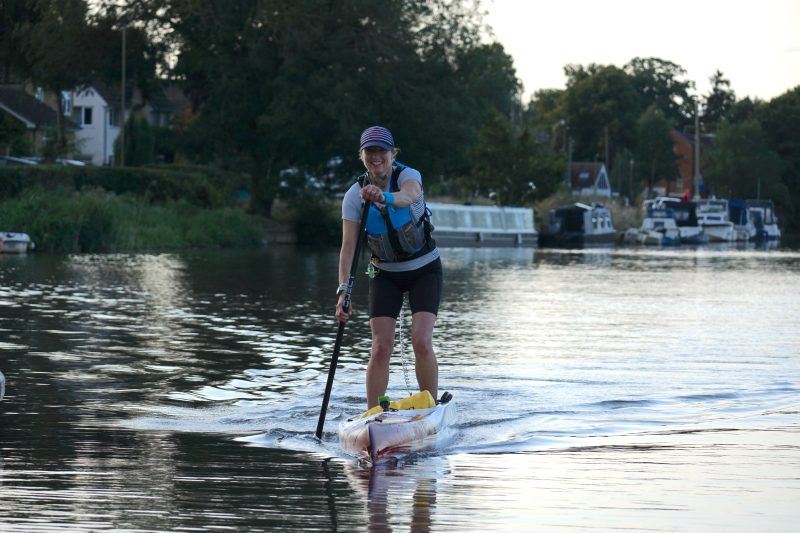
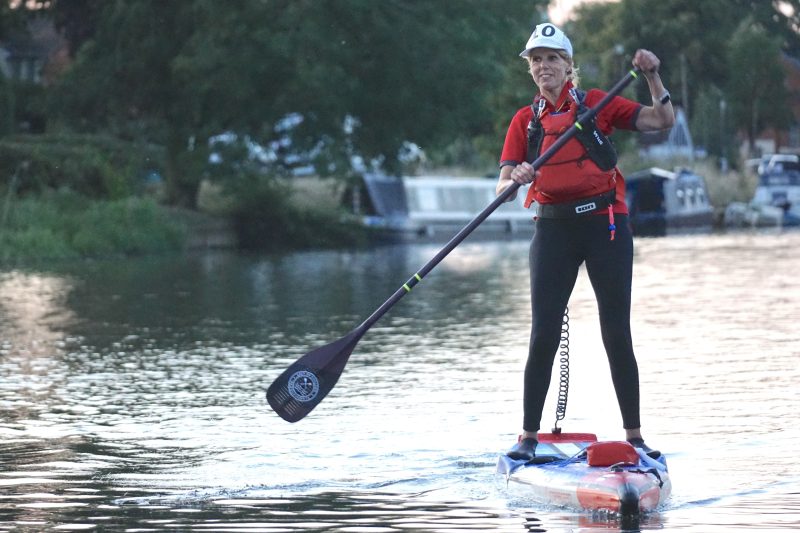
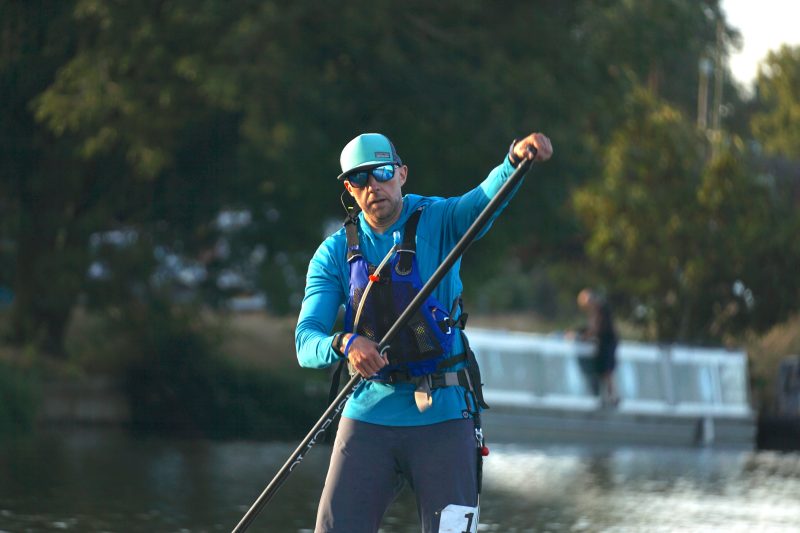
Alex had chosen a 21” x 14 foot racing board for the race, so it wasn’t just the high portages but also the balance required after ten hours that was sending her leg muscles into overdrive. For ultra distances like the Thames 200, balance may not be the first thing to go, but if you lose your balance – you’re done. Unlike blisters, you can’t just power through. Alex consulted with her support crew: would it be safe to get back on the water? The light began to fade as she rested at Abingdon, maximising rest before making a decision.
Emily King, a professional SUP coach and SUP rep to Paddle Wales, was the second SUP woman racing and the answer to Alex’s decision. As Emily stepped off her board and walked toward the refuelling station, Alex greeted her with a big hug. They rested, chatted, and decided to proceed together. Tired legs would recover, and safety concerns suddenly seemed solvable. A few minutes later, Emily and Alex pressed on together.
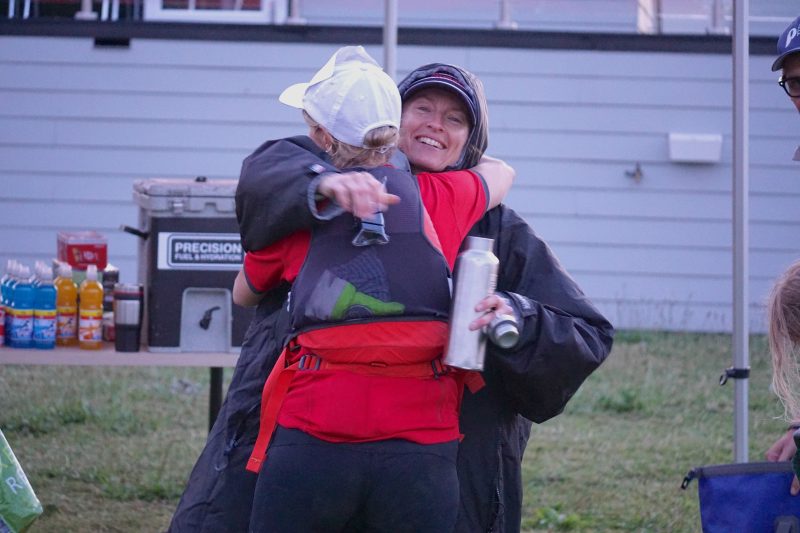
Fifteen hours into the race, Alex was faced with the same choice again. Managing the high portages in pitch black dark was brutal. Having a buddy helped, but safety was paramount. Emily and Alex decided to call it a day. But just like the Fletchers, they’re agreed that the journey doesn’t end here. Emily has already said she’ll be back next year, and Alex is still after the length of the Thames record.
6:21 pm. After a quick stop at Abingdon, Gavin and Chris stuck together as they departed.
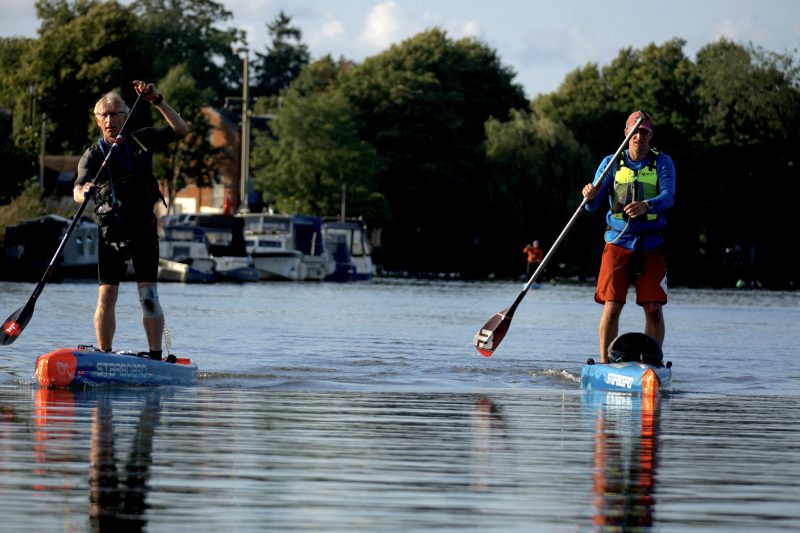
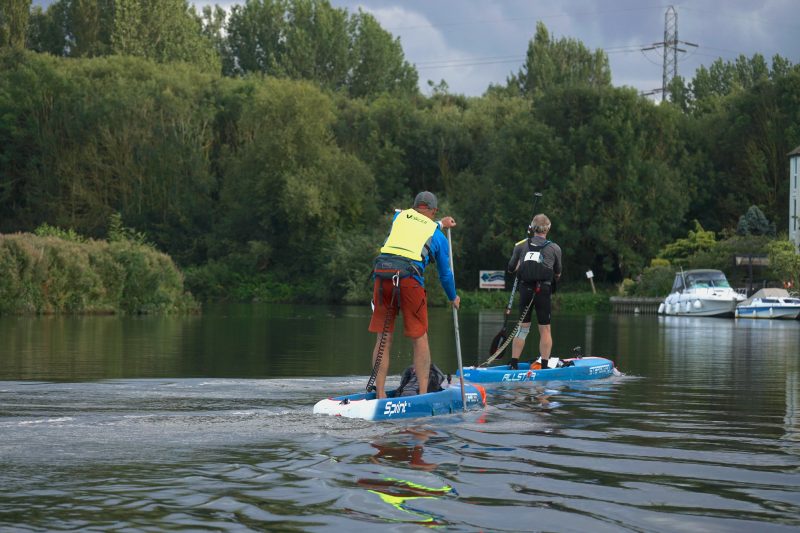
9:43 pm. Moonrise.
They paddled toward nighttime and checkpoint #3: Pangbourne. The moon came out: it glowed orange above the horizon, then rose toward the stars. The river shimmered in its cool light. Gavin and Chris didn’t have quite as hard a time on the portages as Emily and Alex, perhaps in part from having a height advantage. They even found themselves looking forward to the locks as a nice break, though they agreed that the portages were awkward at times. For Gavin, keeping his bag separate from his board was a big help. Rather than wielding a heavier board unbalanced by the kit strapped to it, he could easily grab his bag and then his board which gave him extra manoeuvrability. Like Alex, Gavin used a narrow board for speed efficiency. He was certainly speedy, but ran into the same tradeoff: balance. Gavin said: “When you haven’t got that peripheral vision for balance – my legs really suffered in the nighttime.” The other factor? Not having done much training. As experienced Devizes to Westminster (DW) paddlers and marathon paddlers are well aware, dedicated portage practice makes a world of difference. 44 portages may feel like not many compared to DW’s 77+, but it’s still enough to change the outcome of your race.
2:00 am, ish. The mist.
In the wee hours of the morning, the moon had set and racers along the course found themselves engulfed in thick mist. Several paddlers had already made wrong turns in the dark; now they had to navigate with even less visibility. It was around this time that the leading kayak relay crew, Chelmsford Canoe Club, took a wrong turn and dropped to third. Another kayak crew managed to lead a whole group of kayaks and SUPs towards a weir before realising their mistake and making a quick turnaround – other than some mid-race panic, everyone was fine. On his paddleboard, Craig got lost twice: “This was different to the 11 cities as well at night, because there’s always people, roadways, little villages… whereas the Thames, you’re in the middle of nowhere. I ended up doing 5 km more than the course. I heard the weir, looked around, thought I saw where the river was going, ended up in a boatyard. Came back up to the weir, turned around, ended up where lots of posh boats were moored behind nice big houses, turned around again…”
Luckily for Chris and Gavin at the front of the SUP pack, Gavin had downloaded the GPX file onto his watch and got a buzz anytime he started heading off course. As they arrived at one questionable portage, their doubts were assuaged when the kayakers who’d passed them twenty minutes prior came right back out of the mist to announce that the right way was, in fact, the other way.
6:00 am. The sun returned and dispersed the remaining mist. On the water, Gavin described the sunrise as “totally amazing.” Nearing the end, Gavin started doing mental maths to figure out how much paddling remained. The last 40 km was really hard. Tactically, he didn’t want to leave the win and the record to chance – if he didn’t put some distance behind him, he risked getting overtaken at the finish.
10:30 am. The end of the truce, and a final push.
Although Gavin had been paddling with Chris for the whole race to both of their benefit, it was time to put on the afterburners and take a decisive win. He picked up speed, putting nine minutes between himself and Chris heading into the final checkpoint. Gavin kept pushing the pace, determined to make it a safe win.
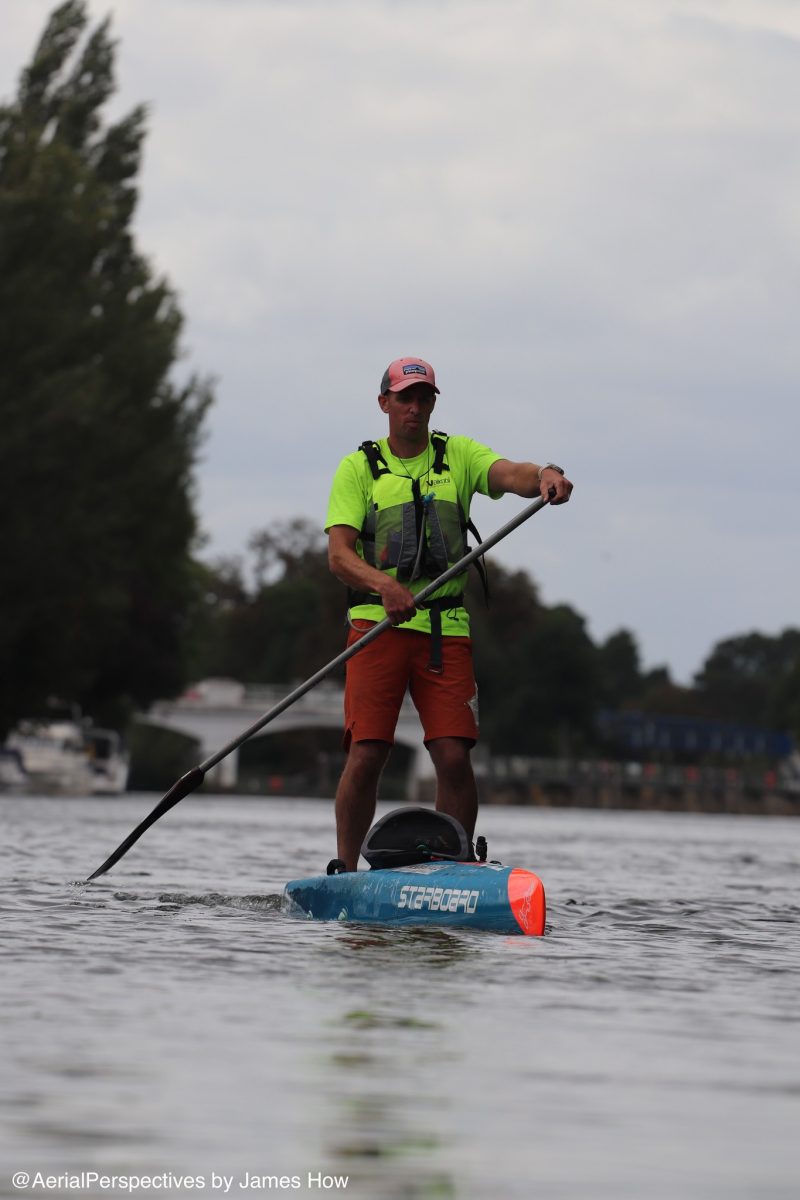
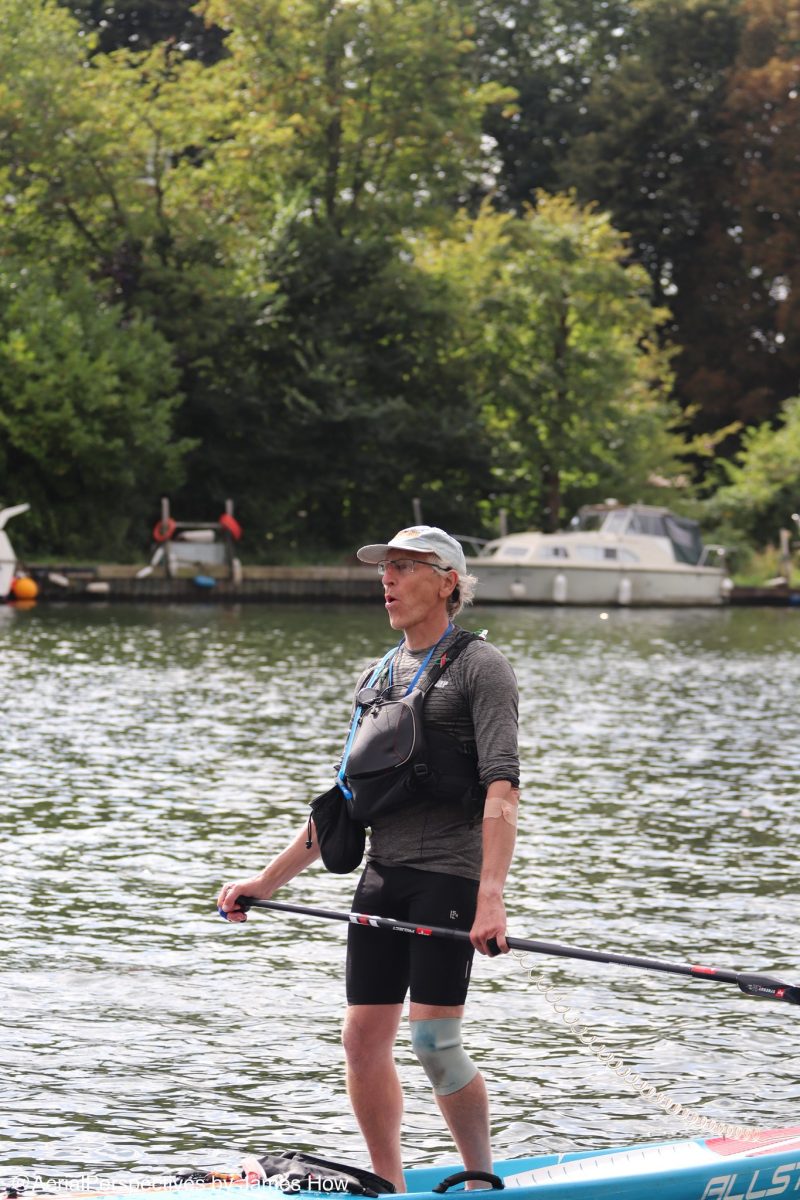
1:34 pm. Lucky for Gavin, the wind picked up and he got to enjoy a nice downwinder for the last 10 km. Chris tried to keep pace, but Gavin was just too fast.
3:19 pm. Gavin arrived at the finish: 29 hours, 19 minutes, and 50 seconds after leaving the start of the navigable Thames in Lechlade. To ensure they’d completed the full length of the Thames, competitors had to paddle 600 metres past the finish to touch Teddington Lock before turning around and reaching the official finish line. Gavin slid up to the pontoon, dropped to his knees, and stepped off his board with slightly more grace than could be expected after 200 km. The race director handed him his finisher’s medal. Celebrating his win and new Fastest Known Time for SUP of the Thames, Gavin said: “I’ve wanted to do that for a long time. To get the fastest known [time].” After an impressively coherent interview for the live stream, shortly before collapsing onto the nicest patch of grass, Gavin said he’s looking forward to more SUPers racing next year: “It’d be good to see other people want to get involved. I’d definitely recommend it.”
3:35 pm. Chris Davison finished just 16 minutes behind Gavin in 29:35:48. For the doubters who needed even more evidence, Chris proved that sub-30 hours on SUP was entirely possible: Gavin wasn’t just an exception.
5:00 pm. The cherry on top: a celebratory headstand.
A couple hours behind Gavin and Chris, Jan Szandala finished in third place: 32:00:20. He’d managed to pass Craig just two hours prior, and held the lead all the way to the end. Jan had quickly developed a reputation as the peppiest paddler since his response to “what’s your number” at the second checkpoint was to do a headstand on his board. Seeing his back upside-down, it was immediately clear: number 5. By the finish, his headstand was much-anticipated: one more for posterity! Craig finished a few minutes later with a final time of 32:09:12. The two paddlers shook hands and embraced.
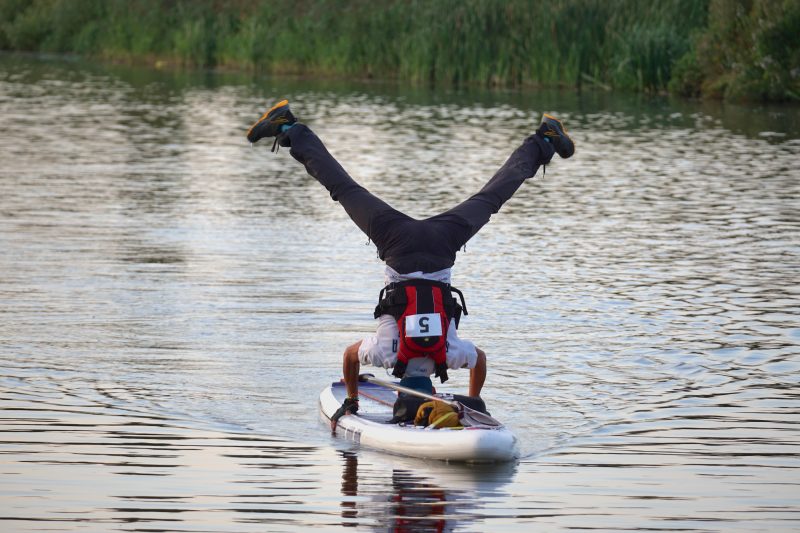
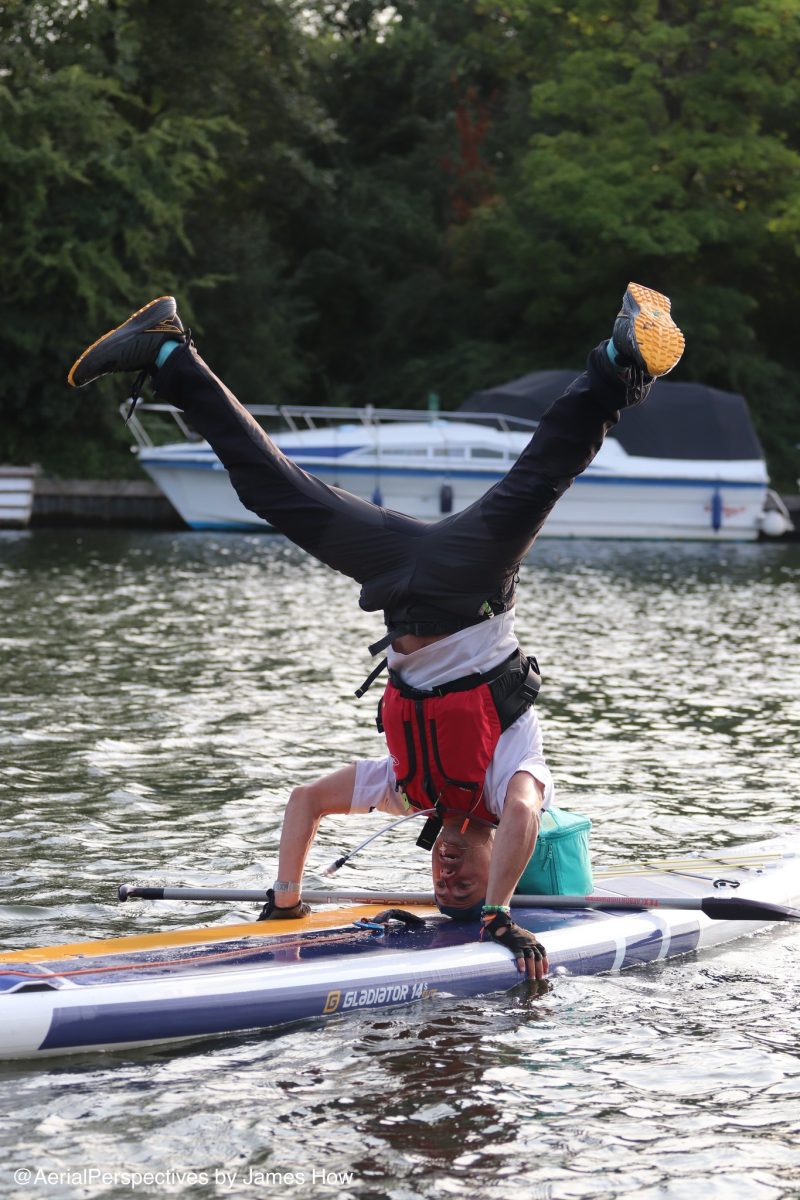
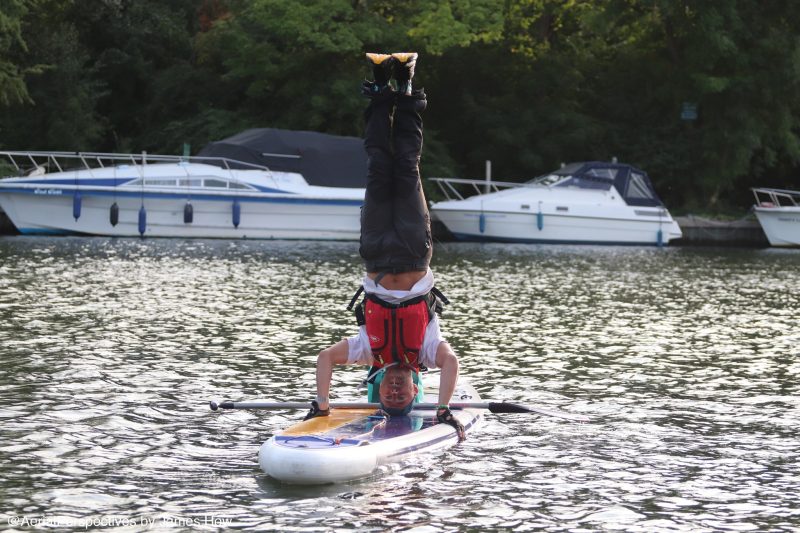
From the second checkpoint at Abingdon all the way to the finish, Jan Szandala kept everyone entertained with his cheeky headstands. At the finish, not only did Jan pull off a headstand after 32 hours of racing, it was also after he put in an extra push at the end to overtake Craig Sawyer for 3rd fasest SUP (photos: Henry Carter & James How)
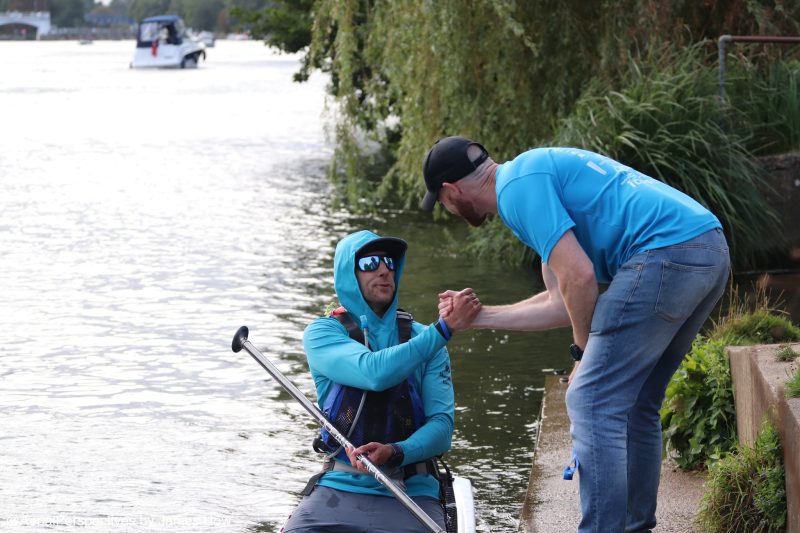
2025?
For its first year, the Thames 200 Ultra hit every single ambitious goal they’d set. Virtually every single racer coming off the water grinned through their fatigue and said they’d be back again next year. In his chat with Supjunkie, Craig Sawyer said “Stand up paddle boarders have a place in a race like this… The record’s been smashed. And now it’s at the point where it’s fun. Because now we’ll see some amazing athletes come out to try and chip away at it.” Craig has already recruited the Dutch SUP 11 Cities champ Ella Oesterholt, who has said she wants to come over next year. Oesterholt won the straight-through 11 Cities race in 28 hours and 2 minutes, second-fastest individual overall (and ahead of fellow racer Gavin Symonds). For a new Thames record next year, in Craig’s words: “my money would be on her.”
Could the Thames 200 Ultra be the UK’s SUP 11 Cities? Rumour has it that race entries for 2025 are opening soon with an early-early-bird discount code… We’ll certainly be keeping an eye on that entry list for next year to see just how far below 30 hours the overall record can drop, and who will be the first to set the records for fastest female and SUP relay team.
In the meantime? Gavin Symonds has already put his name down as one of the first SUPs to sign up for the UK’s most iconic ultra, the Devizes to Westminster (DW). Easter weekend 2025 will mark the first year in a hundred years of race history that the DW has allowed SUPs to enter. Though it’s a similar distance as the Thames 200 Ultra, the first half of the DW is on slow-moving canals with almost twice as many portages… To learn more about the DW, check out SUP Racer’s preview article from 2024 here (yes, that was a correct prediction that they’d start allowing SUPs soon, happy to see that one came true).



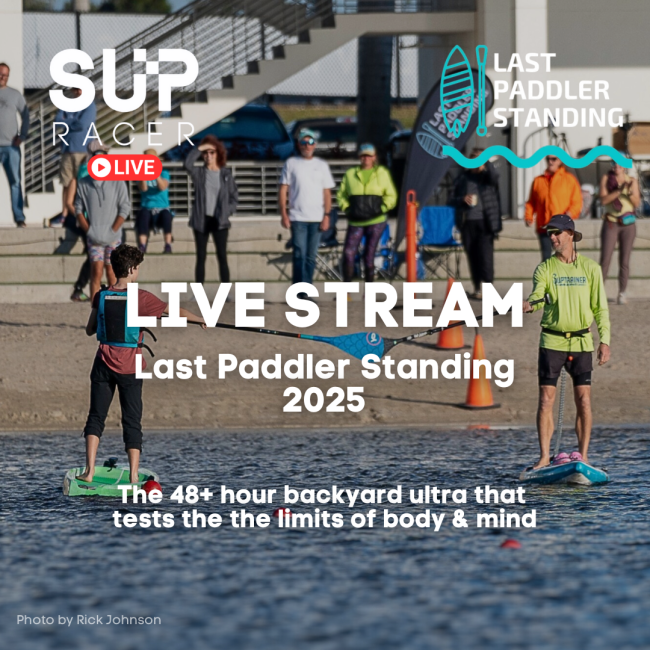
You must be logged in to post a comment.